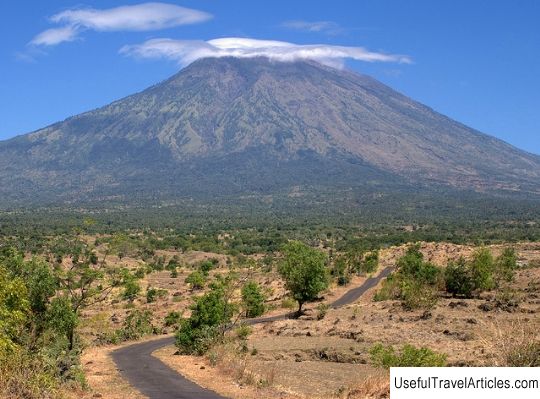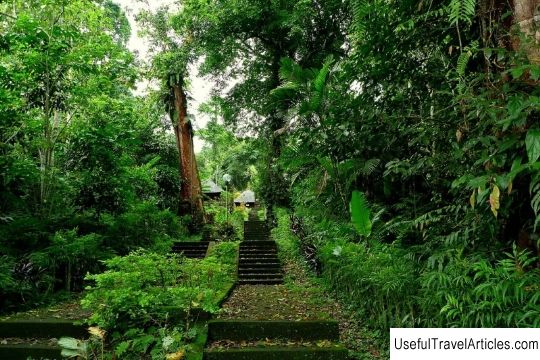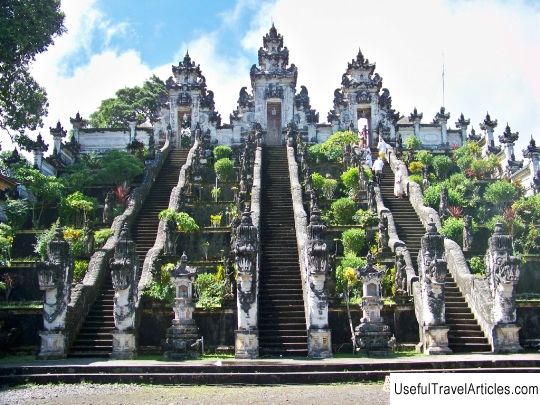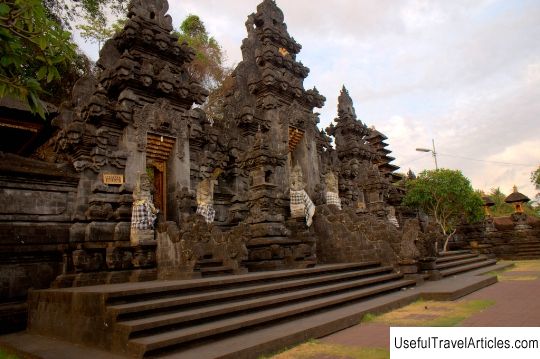Mother Temple of Besakih description and photos - Indonesia: Bali Island
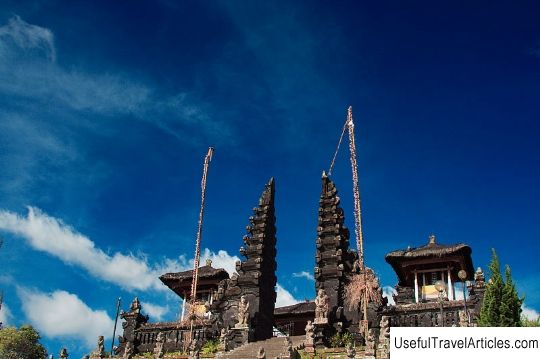
Mother Temple of Besakih description and photos - Indonesia: Bali Island. Detailed information about the attraction. Description, photographs and a map showing the nearest significant objects. The title in English is Mother Temple of Besakih. Photo and descriptionThe Temple of Mother Besakih, or Pura Besakih, is located in the village of the same name, on the slopes of Mount Agung, in the eastern part of Bali. Mount Agung is a stratovolcano, the highest on the island, its height reaches 3142 m. Gunung Agung is considered a sacred mountain and is revered as a shrine. The Balinese also call the mountain "Mother Mountain" because of the ancient beliefs that Agung is the repository of the spirits of their ancestors. The temple built on this mountain is considered one of the most important, large and sacred temple complexes of the followers of Hinduism in Bali. During the last volcanic eruption, in 1963, a lava flow passed literally a few meters from the temple, but the temple was not damaged, and this once again confirmed that this place is sacred. Today the volcano is "sleeping", there is a crater at the top, the diameter of which reaches approximately 500 m. The temple complex consists of many small temples, to be more precise - of 23 structures. The most important temple in the complex is Pura Penataran Agung, which is dedicated to the god Shiva. In addition to this temple, there are even larger ones - the Vishnu temple and the Brahma temple. The remaining 20 temples are small. The entrance to the temple complex is made in the form of “split” gates, traditional for Bali, which are called Chandi Bentar. Having passed this gate, guests enter a beautiful green area, and from there, through another beautiful gate of Kori Agung, into the second courtyard. Each temple is dedicated to a specific god and is visited by Balinese people from certain regions or belonging to a particular caste. The temple complex consists of many small temples, more precisely, of 23 structures. The most important temple in the complex is Pura Penataran Agung, which is dedicated to the god Shiva. In addition to this temple, there are even larger ones - the Vishnu temple and the Brahma temple. The remaining 20 temples are small.The entrance to the temple complex is made in the form of “split” gates, traditional for Bali, which are called Chandi Bentar. Having passed this gate, guests enter a beautiful green area, and from there, through another beautiful gate of Kori Agung, into the second courtyard. Each temple is dedicated to a specific god and is visited by Balinese people from certain regions or belonging to a particular caste. The temple complex consists of many small temples, more precisely, of 23 structures. The most important temple in the complex is Pura Penataran Agung, which is dedicated to the god Shiva. In addition to this temple, there are even larger ones - the Vishnu temple and the Brahma temple. The remaining 20 temples are small.The entrance to the temple complex is made in the form of “split” gates, traditional for Bali, which are called Chandi Bentar. Having passed this gate, guests enter a beautiful green area, and from there, through another beautiful gate of Kori Agung, into the second courtyard. Each temple is dedicated to a specific god and is visited by Balinese from specific regions or belonging to a specific caste. In addition to this temple, there are even larger ones - the Vishnu temple and the Brahma temple. The remaining 20 temples are small.The entrance to the temple complex is made in the form of “split” gates, traditional for Bali, which are called Chandi Bentar. Having passed this gate, guests enter a beautiful green area, and from there, through another beautiful gate of Kori Agung, into the second courtyard. Each temple is dedicated to a specific god and is visited by Balinese people from certain regions or belonging to a particular caste. In addition to this temple, there are even larger ones - the Vishnu temple and the Brahma temple. The remaining 20 temples are small.The entrance to the temple complex is made in the form of “split” gates, traditional for Bali, which are called Chandi Bentar. Having passed this gate, guests enter a beautiful green area, and from there, through another beautiful gate of Kori Agung, into the second courtyard. Each temple is dedicated to a specific god and is visited by Balinese people from certain regions or belonging to a particular caste. and from there through another beautiful gate of Kori Agung - into the second courtyard. Each temple is dedicated to a specific god and is visited by Balinese people from certain regions or belonging to a particular caste. and from there through another beautiful gate of Kori Agung - into the second courtyard. Each temple is dedicated to a specific god and is visited by Balinese from specific regions or belonging to a specific caste.    We also recommend reading National Museum of Wroclaw (Muzeum Narodowe we Wroclawiu) description and photos - Poland: Wroclaw Topic: Mother Temple of Besakih description and photos - Indonesia: Bali Island. |
